Out of all the handheld power saws out there, jigsaws seem to be the most underrated. There are probably more than a few reasons for this, ranging from confusion over what a jigsaw even is (and isn’t,) and what they can be used for in the first place.
In actuality, a jigsaw is one of the most versatile power saws you can buy, and also one of the most cost-efficient. They are also easy to use, easy to maintain, and don’t require a lot of experience before you get the full grasp of one.
So, if you are even slightly confused about why someone would want to use or own a jigsaw, or are simply wondering about the basics of one, this is the right place to be.
Below, I’ll introduce you to one of my favorite power saws, which includes covering how they came to exist, what they’re best for, why you may need one yourself, and more.
As with any saw, it’s best to begin be properly defining what it is, so we’ll start with that and go from there.
What Is A Jigsaw?
A jigsaw is a handheld power saw that uses a reciprocating blade in an up and down motion. The saw it held in place by a shoe, which is used to glide along the surface of whatever it’s cutting.
The blade is on the small end of the spectrum (more on that in a moment,) making the saw appropriate for cutting finer cuts and patterns into materials. In many ways, a jigsaw is seen by many as a mobile version of a scroll saw, but it actually shares some core characteristics with reciprocating saws as well.
Jigsaws are often very compact, and typically simple in design. The main differences amongst one jigsaw to another usually revolves around the size, power, and handling.
While jigsaws are small, they can be very useful for a large number of tasks and projects, especially when trying to use a different handheld saw that may not be as good of a choice due to certain limitations.
When using a jigsaw, you bring the saw to the workpiece, which can either be mounted, or part of a larger structure, such as a counter, wall, ceiling, etc. They are incredibly mobile, somewhat light in weight, and have a very straightforward operation with little variance.
A Brief History Of The Jigsaw
The development of the jigsaw is relatively simple.
In 1946, a Swiss man named Albert Kauffman decided to replace the needle on his wife’s sewing machine with a mini hacksaw blade. This idea was natural for a man like Kauffman — he was on staff of the Swiss power tool manufacturer Scintilla AG.
The idea quickly became a hit, and the company began to manufacture the saws soon after, and Bosch actually picked up on it as well. Due to some drama surrounding WWII, the name was changed to the Lesto Jigsaw. This early version remained stationary, which would eventually turn into a prototype of today’s scroll saws.
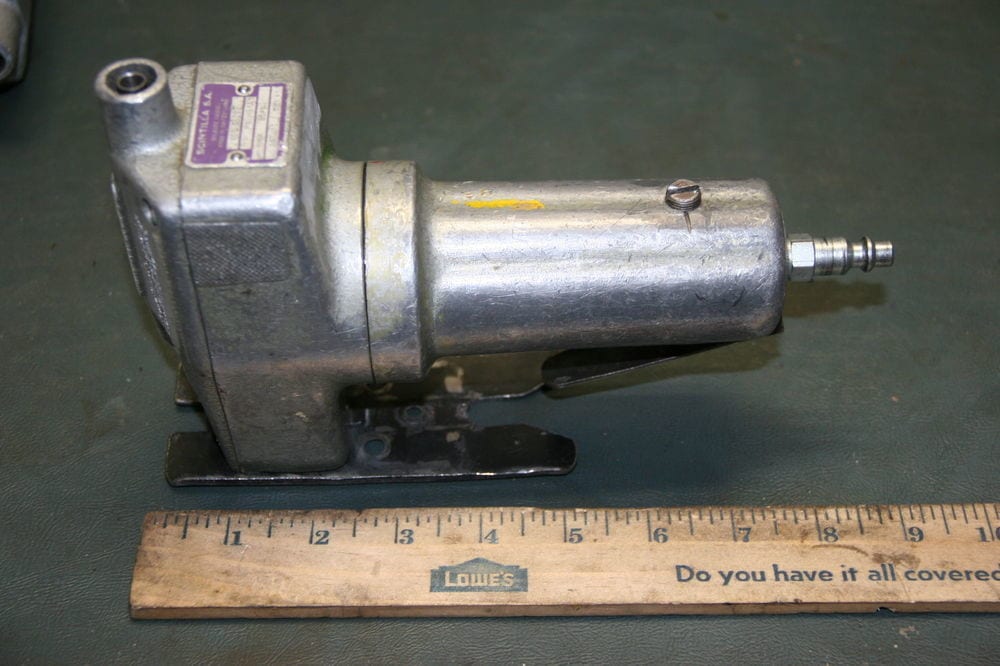
Over the next few decades, the jigsaw evolved thanks to the work and innovation of many different companies. By the 1980s, the electric jigsaws we now have today had become commonplace, with any noticeable improvement revolving around power, speed, and size.
During this time, jigsaws had several other names, which I’ll briefly go over below.
Is a Jigsaw a Saber Saw?
Okay. With many power saws, there is a lot of semantics involved, with a lot of people using different terms to refer to the same thing. For instance, some people call reciprocating saws “Sawzalls,” which is actually a brand (kind of like people calling any soda beverage a “Coke.”)
This is the most true in regards to jigsaws. You’re likely to hear someone call a jigsaw a saber saw at some point. Furthermore, you may see it spelled either sabre, or saber. For the most part, older generations refer to jigsaws as saber saws.
In reality, they are likely referring to the same thing. To make things even more complicated, some people call reciprocating saws saber saws. Add in the fact that you can find old scroll saws referred to as jigsaws in catalogs from several decades ago, and well, you get the idea.
Sabre saw, saber saw, jigsaw, jig saw — they are all likely referring to a jigsaw.
So, if you hear someone talk about a saber saw, know that it’s probably a jigsaw,but don’t expect to see a jigsaw marketed or sold as a “saber saw.”
Got it? Good.
What Is The Difference Between a Scroll Saw And a Jigsaw?
Now this is where you can find some actual differences, aside from just names.
As I just mentioned, jigsaws and scroll saws were the same thing at one point — or at least they were marketed that way. However, over time, they began to refer to totally separate tools.
A scroll saw does share a lot of similarities with a jigsaw in how it operates. Scroll saws are mounted and have a table surface, with the saw portion located towards the middle. They look kind of like a band saw, with an exposed cutting surface coming through a slot in the table.
When turned on, the saw blade moves up and down in a rapid motion, exactly like a jigsaw. The blade itself is also on the thinner side of things, though it can depend on what type of blade is being used.
The profile, design, and cutting action of a scroll saw makes it appropriate for cutting intricate designs into a material, which is usually wood. The user feeds the material into the saw blade, and moves the material around as needed to make the cuts. These cuts generally involve curves.
In a way, a jigsaw can be seen are more of a portable version of a scroll saw. It can make curved cuts, uses the same blade action, and a similar style of blade. It also has a “table” of sorts, which is really the shoe of the saw that you lay onto the material as you’re cutting.
That’s where the similarities end. Scroll saws are stationary, more appropriate for smaller, more intricate cuts, and also offer some types of blades you can’t use with a jigsaw, such as a spiral blade.
Jigsaws take the cutting style of a scroll saw, and convert it to a more mobile version where you bring the saw to the material, rather than vice versa. Furthermore, they are more heavy-duty in a sense, and can often be depended on for construction tasks just as easily as they can for crafting and design work.
Is a Jigsaw Basically a Reciprocating Saw?
Again, back to the semantics of it all.
A reciprocating saw is one of those saws named for what it actually does: reciprocate. That simply means the blade moved back and forth to create the sawing motion, unlike a circular saw that spins, and a band saw that uses a rotating blade on a wheel.
So yes, in a way, a jigsaw is a reciprocating saw in that it uses a reciprocating blade.
However, for all intents and purposes, a reciprocating saw now refers to a number of characteristics. These saws use a larger blade that sticks out from the front, so you kind of hold it like it’s a drill.
Reciprocating saws are also not the best choice for making finer, more accurate cuts. In fact, they’re not really supposed to be. These saws are more for construction purposes, such as cutting holes in drywall, cutting off studs that are sticking out, breaking down materials, and so on.
On the other hand, jigsaws do use a similar setup, but the saw blade is angled downwards, rather than straight horizontally. A jigsaw uses a smaller blade too, and is much more appropriate for cutting accurate shapes into materials.
(FYI: For more saw comparisons, head over to our blog section.)
What Can Jigsaws be Used For?
This is my favorite part about jigsaws. They can perform a lot of functions that other saws can on their own, but in an all-in-one package.
DIY Projects
The ability to cut a smooth, seamless curve with a handheld saw cannot be overstated enough. Ever tried to cut a curve with a circular saw? How’d that work out for you? I’m assuming not very well. You probably bent the blade in the process.
A reciprocating saw can make curved cuts, but it’s not going to be very pretty. You’ll likely have to sand it down afterwards, or use a different saw to get things looking a little better.

A jigsaw brings the gentleness and precision of a scroll saw to your onlocation projects, whether that’s cutting laminate pieces for your floor, cutting tile, or cutting a hole in your counter to install a sink.
Anything that can be cut with a jigsaw-sized blade, the jigsaw can handle. Since it’s a mobile handheld saw that can make plunge cuts, you can pretty much do whatever you want with it, as long as it’s within the realms of what your particular model and blade can handle.
Hobbies
A jigsaw can definitely fall within the category of fine woodworking tool. It may not be on the level of a scroll saw, but it comes pretty close. You can use a jigsaw to make curved and irregular cuts on larger pieces of wood and other materials.
As long as the thickness is within the limit of the jigsaw, you can cut it, regardless of how big it actually is in circumference or diameter. This makes the jigsaw incredibly versatile for infinite types of hobby work.
Crafting
The heavy-duty aspect of a jigsaw doesn’t not mean it can’t be used for smaller tasks as well. You can always purchase smaller blades for finer crafting projects, or for different materials.
Some examples of crafting you can use a jigsaw for include making wooden decorations, cutting letters and shapes out of thin metal sheets, and even carving pumpkins. (Seriously, think of how fast you could carve a pumpkin with a jigsaw.)
Just as with hobby use, a jigsaw has seemingly infinite crafting capabilities for a ton of different materials, so I’ll stop right there.
Construction
This is where a jigsaw may be the most effective and useful. You’re basically getting the durability and fortitude of a recip saw, but with the accuracy and precision of a band saw — but in a handheld version.
When undertaking certain construction tasks, this can give you a huge advantage, and even skip over some steps, or enable you to do more with less types of saws on hand.
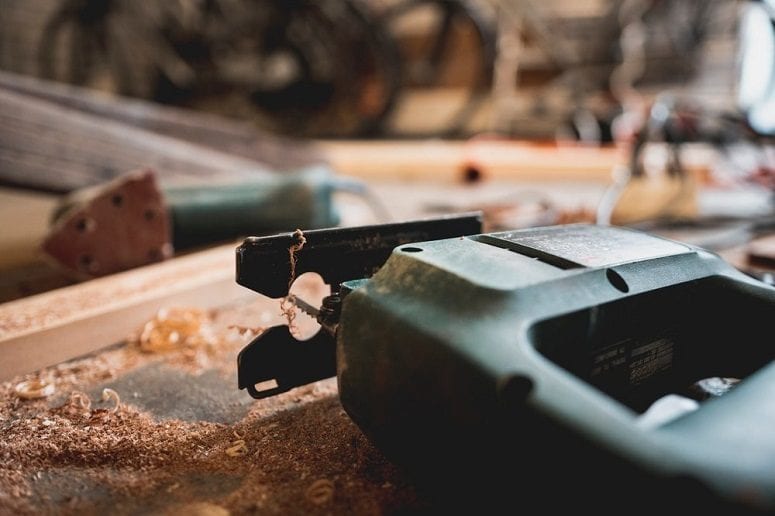
A jigsaw can usually cut through most walls and flooring easily when equipped with the right blades. The same can be said for tile, certain types of concrete, and thinner metal materials as well.
This can result in faster, cleaner installations for things like sinks, shelving, cabinets, decor, and much, much more. You can also use a jigsaw for smaller rip cuts, and for general destruction and breaking down of items and structures that are in the way, or needing to be removed.
Again, give a jigsaw the right blade, and it can do pretty much anything, as long as you have a steady hand.
Do I Really Need a Jigsaw?
This is always the question someone will inevitably ask themselves about most any saw. My answer is a quick “yes” when it involves any type of saw, but that’s me.
Do you need a jigsaw? Well, that depends. If you’re looking for a versatile saw that can do pretty much anything, than yes, you do.
I’ve already touched on all the things a jigsaw can do, but let me reiterate in a more simpler way.
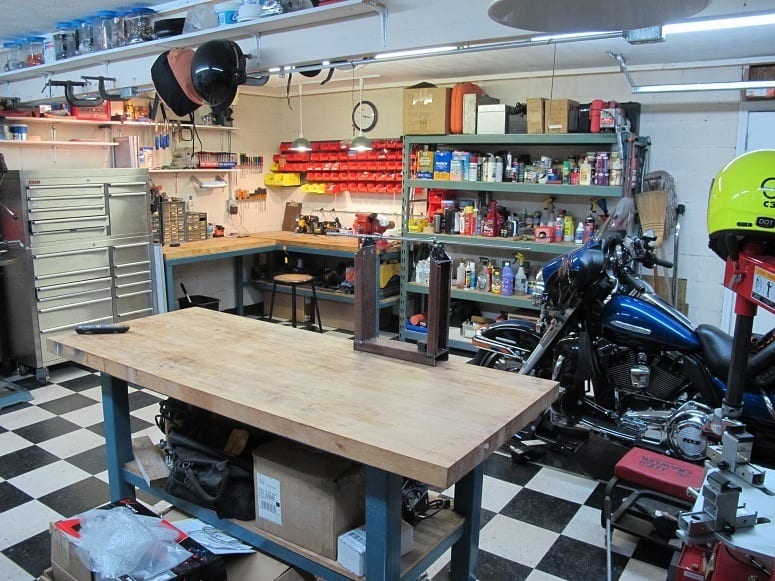
A jigsaw can cut curves just like a scroll saw can most of the time. It can cut into walls, floors, ceiling, and whatever else, much like a reciprocating saw can. It can make rip cuts on small pieces of wood like a circular saw can.
When you get a jigsaw, you’re getting — at a minimum — a 3-in-1 power saw that not only cuts in several different formats, it’s also mobile, easy to handle, and you can find plenty of models that are incredibly affordable, and still perform well.
I will also reiterate that this is all true as long as the things you are cutting stay within the depth of cut limit of your blade or model, but still. A jigsaw is an essential power tool that is as accessible as it is easy to use, and you don’t have to be an expert with tools or saws to appreciate one.
Do you need a jigsaw? Yes, you probably do.
Anatomy of a Jigsaw
Knowing the parts of a jigsaw will allow you to gain a better understanding for how it works, and its capabilities.
We won’t cover every last piece and part of a jigsaw, but below are the main components you should definitely know about.
Motor
Something has to power the blade after all. Jigsaw motors are relatively small, yet are usually capable of putting out quite a bit of power. Powered jigsaws will typically be measured in amps, and the higher the amps, the more power the motor has.
A jigsaw motor is a little more powerful than a circular saw motor, as the smaller blade of the two requires more force to do its work. As with other electrical power saws, you won’t have to worry about any maintenance, fuel, oil, etc.
Blade
Obviously the most important part, the blade is the piece that will be doing all the cutting. The jigsaw blade moves up and down, and is only exposed enough in terms of the saw’s depth of cut. The only part of the blade that will be doing any cutting is the part sticking out from below the shoe.
The blade is attached to the saw body and motor through a clamp that is either tightened and loosed with a hex key, or using a tool-less setup designed by the manufacturer. The blade runs through a blade guide on the way down, which helps keep it in line and straight when making cuts.
There are several different types of blades available, which we’ll go over further on down.
Trigger
As you may have guessed, the trigger is what’s used to control the blade’s speed. While there are still some obsolete and outdated jigsaws out there with one speed, most jigsaws these days have a variable speed control that is reliant on how hard you press down on the trigger.
If you want to go full speed, simply press all the way. Need a slower speed? Lightly press the trigger until you have the speed where you’d like.
More advanced jigsaws have speed dials that will let you select a maximum speed, so that when you pull the trigger all the way, it won’t go past that speed. This helps for the times when you’re doing very intricate cuts and don’t want to worry about trigger pressure while also having to guide the blade as precisely as possible.
In addition to a dial, some jigsaws have a trigger lock that you can use to keep the blade going, without having to hold the trigger down the entire time, which can be convenient for certain situations.
Handle
This one is pretty self-explanatory, but worth going over. The jigsaw handle is used to control and guide the saw as you move it across the object you’re cutting. The handle is usually coated in some sort of material that prevents slippage, and may also have some padding.
High-quality jigsaws usually have thick rubber covering on the handle that helps absorb shock, which eases the strain on your hand, and leads to more precise cuts.
Shoe
The shoe is the bottom portion of the jigsaw, and is where the blade protrudes out and down from. The shoe is used as a guide, keeping your jigsaw level and straight as you cut across the material you’re sawing.
The shoe can also determine the angle of the cut, just like other power saws. Most jigsaws these days have bevel capacities that go all the way to 45 degrees. This is done by tilting the shoe, and locking it in place.
Shoes can also have a number of accessoires and designs that help improve performance — and protect what you’re sawing. Many jigsaws come with plastic slips that you can put over the shoe, which protects fragile surfaces from being scratched by the shoe, which is almost always made of metal.
Orbital Control
Orbital cutting movements are a major advantage for jigsaws, and most models made today come with orbital cutting capacities to at least some degree.
An orbital cut on a jigsaw is when the blade moves back and away from the cut line after it’s made the cut.
For example, the saw blade will move downward to make the cut, and as it goes back up, moves slightly back.
There are several reasons as to why this is an advantage, mostly having to do with preventing splintering, and also minimizing debris.
An orbital control lets you choose the orbital cutting in order to better match the desired speed, and the material that you are sawing.
Types of Jigsaw Blades
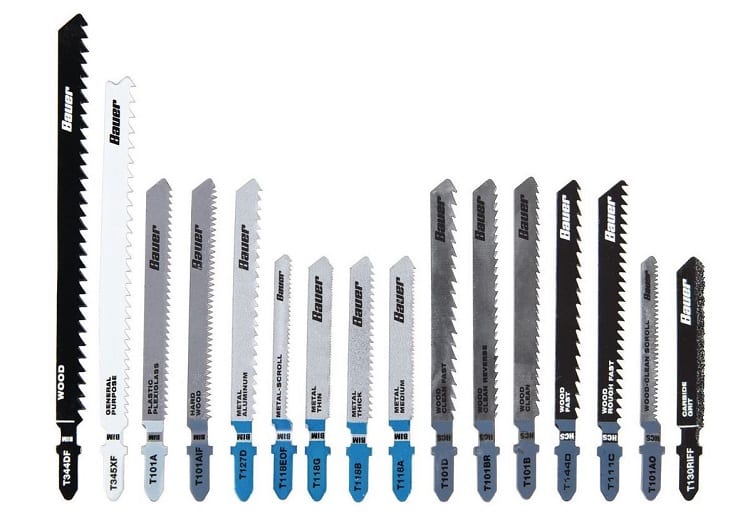
Part of the versatility with jigsaws revolves around the many different types of blades you can use with one. Each blade type and material have certain advantages for certain cutting scenarios.
Shapes
One thing you’ll quickly notice when shopping for jigsaws and jigsaw blades is the use of the terms U-shank and T-shank.
The names are indicative of how the tops of each blade are shaped. This does not affect performance or anything like that; it simply refers to the way the blade is attached to the jigsaw.
T-shanks have a T-shaped top, and U-shanks have more of a U-shaped top.
T-shank blades are mostly preferred now by manufacturers, but there are also many new jigsaws coming out that are capable of using both. Just make sure to check the manufacturer’s info in case you have some blades around you’re wanting to use.
Jigsaw Blade Fabrication
Jigsaws have several different blade fabrications, each with different abilities and advantages for distinct materials and cuts.
High Carbon Steel
High carbon steel blades are the most commonly used jigsaw blades. They are usually very inexpensive, but also more flexible than other saw blades. They also wear down the quickest.
This isn’t a knock on them or anything. In fact, many jigsaw users will be completely satisfied with using high carbon steel blades, as long as they are only sawing thinner, softer woods most of the time.
High Speed Steel
High speed steel blades are also very common. These blades are a bit thicker than other types, which also means they heat up faster, while offering very little flex in the process. However, they are still among the most durable when used correctly, so you won’t be replacing them nearly as often.
A High Speed Steel blade is very suitable for cutting hardwoods, but it’s also usually a good choice for cutting plastic, and some thinner metal materials too.
Bi-Metal
A bi-metal blade is a solid compromise between high speed steel, and high carbon steel. Why is that? Well, as the name indicates, it’s actually a mixture of both. This means that you get a small amount of flex, decent heat control, and some good durability on top of it.
Bi-metal jigsaw blades are a good choice for cutting hardwoods, and some metals, especially when you’re going to be making longer or more frequent cuts during one sitting.
Tungsten Carbide
These blades are exceptionally tough, something you’re already aware of if you’ve used these types of blades with other saws. A tungsten carbide blade has been coated in tungsten carbide grit, so the cutting portion is not the standard metal material.
A tungsten carbide blade can handle tougher materials with ease, while also leaving a smooth surface and no splintering. This is especially useful for materials like ceramic, steel, and fiberglass.
Types of blade teeth
In addition to different blade materials, there are a few different blade teeth designs you should know about.
Taper
Blade teeth with a taper pattern are set in a straight alignment, making the blade best for slow cuts with a very fine edge.
Wavy
Wavy teeth are aligned in alternating short and long lengths, and work best when making a straight, fine cut.
Side
Side teeth are offset, and are best used for making rough, fast cuts, when the edge smoothness is not a factor.
Reverse
A reverse blade uses tapered teeth, but in the opposite direction. This creates a cut on the way down instead of up, whis is ideal for fragile or brittle material more prone to chipping.
Teeth Per Inch (TPI)
Teeth per inch refers to the amount of teeth condensed within one inch of the blade.
The more teeth located within an inch, the finer the cut will be, and vice versa. Jigsaw blades with 6 to 20 TPI are typically used for wood cutting, while blades exceeding this amount are more commonly used for cutting metal, plastic, ceramic, and so on.
Jigsaw blades with a high TPI almost always have shorter length on the teeth.
Notable Manufacturers of Jigsaws
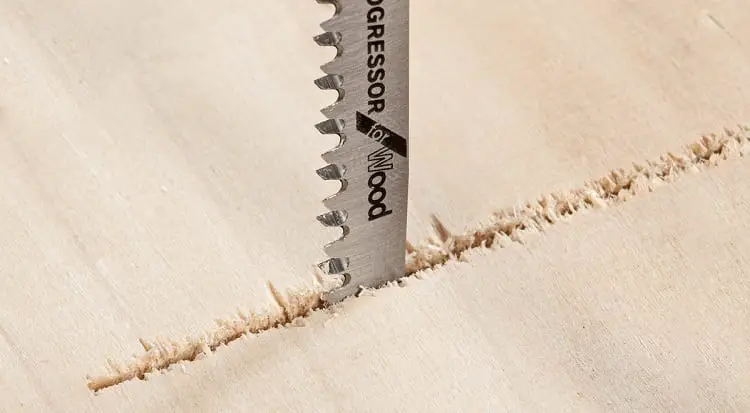
There are more than a few companies that manufacture jigsaws, but the ones listed below are among the best, and the most established.
Skil
Skil is easily one of the most recognizable jigsaw makers, and also one of the best makers of any power saw. The company got its start in the early 1920s within the confines of New Orleans, Louisiana. Edmond Michele was the founder, and was actually the man credited with inventing the circular saw.
Skil makes jigsaws on a variety of levels and price ranges, but their budget-minded jigsaws are especially impressive, and routinely perform above their price range, making them one of he best buys in all of the power tool world.
Makita
Makita has a very unique history to where they are today. The company started off in Japan in 1915, and was founded by Saburo Makita. He initially sold lighting equipment and motors for years, but WWII brought about some changes, and after the war, the company focused on power tools after nearly being wiped out.
Many consider Makita power tools and saws to be among the best you can get before climbing into the highly expensive professional and industrial-level tools. Their jigsaws fit that description perfectly, offering superior performance for the slightly extra price.
DEWALT
DEWALT is widely recognized on the name alone, but the bright yellow trademark color scheme is hard to miss as well. The company originally came into being in the early 1920s as well, founded by Raymond E DeWalt — the company’s obvious namesake.
After reorganizing in 1947, DEWALT quickly established a reputation as a make fine power tools, offering extensive product lines for both professionals, and the average DIYer and homeowner. They’ve been doing the same ever since, and their jigsaws are among the best, especially their cordless versions.
Bosch
Bosch is one of the oldest power tool brands in the world. So old in fact, that the company dates back to a time before power tools were even really a thing. Robert Bosch started the company in Stuttgart, Germany, in 1886.
Today’s Bosch tools have a reputation for combining solid, durable design with advanced features, and that definitely applies to their lineup of jigsaws, which boast professional-level ruggedness, and an array of added features.
Black + Decker
Black + Decker really doesn’t need much of an introduction, as the company has become a favorite in the western part of the world for making consumer-level power tools for extremely economical prices, and all without sacrificing quality and performance.
Many of their jigsaws are priced for entry-level, but operate and feel like they’re worth twice the price. The company has a hand in several other brands as well, including Porter-Cable.
Jigsaw Safety Tips
Jigsaws are saws…so you need to do everything you can to be as safe as possible each and every time you use one, regardless of the size of the job, or length of use.
Here are a few surefire jigsaw safety tips you should follow:
Always read the owner’s manual before using. Not every jigsaw is the same, and some products may have different ways they operate, different ways to detach a blade, lock in blade speeds, etc. It’s best to know beforehand, rather than learning on the go.
Always wear protective equipment, no matter what. This includes covering your eyes, wearing gloves, and sometimes a dust mask as well. You never know when sawdust or debris could fly towards you. Don’t take chances.
Don’t ever try to force a jigsaw, especially when cutting harder or tougher materials. There are simply too many things that could go wrong, such as snapping the blade, cutting yourself, breaking the material, etc.
If you’re using an extension cord, always be aware of where it is. The last thing you want to do is trip while having a saw running, or cause an accident with someone else on a jobsite.
Another thing to be aware of when using a corded jigsaw: moisture. Don’t even plug the saw in if there is moisture around the outlet, on the ground, or anywhere else in your workspace.
Don’t use a dull blade. Doing so can cause slips, or cause you to force the issue too hard, and result in any number of accidents. Replace the blade if needed.
Avoid using the jigsaw in cramped spaces, and don’t ever use one when someone is nearby, or behind you. You should also make sure the cutting area is clear in every direction.
How to Use a Jigsaw
Jigsaws have a lot of different uses, and some of them require certain approaches and methods in order to go smoothly and result in a quality cutting job.
Here are some general instruction for how to use a jigsaw in a standard scenario:
- Start off by mounting the appropriate blade for the material. Give the blade a quick inspection to make sure it’s good to go, and then mount it according to manufacturer’s instruction. Ensure that it’s set properly.
- Prepare the material you’re about to cut. If using the material is free from a structure, make sure it’s clamped down and secured, and that the cut lines are drawn exactly as the cut needs to be.
- Adjust the settings of your saw to match the material and type of cut. If you’re cutting metal, ceramic, and other non-wood materials, be sure that you have the right speed locked in.
- Line your saw blade up with the cut line, and ease into that first cut by slowly squeezing the trigger, until the blade catches the material and begins the cut without you needing to exert too much force.
- From there, slowly follow the cutline, doing your best to not stop the blade’s operation until you’ve gotten all the way to the end. Focus on the cut line, and make sure the blade is handling the task properly, without splintering or chipping.
- Complete the cut all the way through, check the cut to make sure it’s okay, and then quickly inspect the blade before moving onto the next task.
- When you’re all finished, give the saw a quick wipe down with a dry rag, and store it away.
Jigsaw Maintenance
Another great thing about jigsaws is how they don’t really require a great deal of maintenance. This largely has to do with the face that they’re all electric-powered, so there’s no need to worry about gas engines, or lubing a chain like you would with a chainsaw.
With that said, there are some simple steps you’ll need to take from time to time.
Cleaning the saw off is something you should do after every use. All you need to do is take a dry rag and wipe the saw down, while paying close attention to any crevices, and the blade assembly area.
You can use a clean used toothbrush to clean out the blade guide, and where the blade is inserted. (Keeping your jigsaw in a case will prevent dust build-up, and protect it from dings as well.)
Every so often, you may need to apply a single drop of lubricant to the blade guide to prevent it from jamming.
If you’re using a corded jigsaw, check the electrical cord every now and then to make sure there aren’t any cuts, frays, or wear. If you use a cordless, check the battery for dents, and ensure that the connectors are clean on the battery, and in the saw.
That’s it!
Follow those simple steps and your jigsaw will last for years, maybe even decades.
Conclusion
Hopefully by now you see why there is so much enthusiasm for jigsaws. Aside from their versatility, these saws are always easy to use, adaptable to a number of different materials, and appropriate for everything from advanced woodworking, to basic rip cuts on construction materials.
Like many other saw users, I consider the jigsaw an essential power tool that everyone should have in their garage or shop. Are you ready to start looking for one?
Be sure to check out our buying guide, which highlights six of the best jigsaws on the market, and also gives you some helpful advice on how to shop for one.

